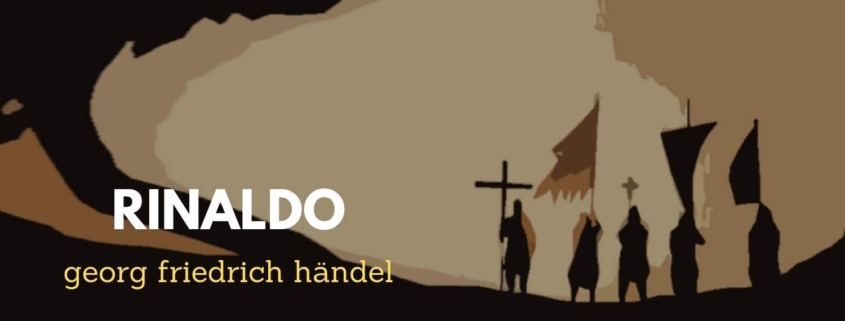LASCIA CH’IO PIANGA – an aria from Rinaldo
The opera guide tp George Frederic Händel’s aria LASCIA CH’IO PIANGA
Read Interesting facts and hear great YouTube Videos about Händel’s famous Aria “LASCIA CH’IO PIANGA“.
If you want to read and hear more about RINALDO, click on this link to the opera portrait
The aria LASCIA CH’IO PIANGA – Synopsis and background
Synopsis: Jerusalem is besieged by the crusaders. In the Christian camp are their leader Goffredo, his daughter Almirena and his commander Rinaldo. Goffredo promises Rinaldo the hand of his daughter Almirena as a reward when they defeat the sarazenes. She joyfully awaits her marriage with the commander and urges him to fight. Argante, the ruler of Jerusalem demands 3 days of truce, which Goffredo, sure of victory, generously grants him. Argante wants to gain time to make a plan with his wife, the sorceress Armida, to change the fortunes of war in their favour. Armida sees their only chance if they succeed in eliminating Rinaldo. Without his martial arts the Christians would not be able to take Jerusalem. So Armida kidnaps Almirena before Rinaldo’s eyes with the help of magic. She appears from a black cloud with monsters at her side, against which Rinaldo is powerless. She is kept in the garden of the castle of Almira, where she lonely laments her fate.
Lascia ch’io pianga is one of the most famous arias by George Frideric Handel. He had already composed it in 1705, and transformed it into a lament aria for the opera Rinaldo. Händel managed to write an aria that is touching by its simplicity.
He wrote the aria in the form of a sarabande, a triple measured dance with a stretching of the second bar. The combination with the typical chromaticism and the pause result in the famous sighing motif of Handel’s lamentos. We hear this effect right at the beginning:
Soon Handel leads the voice up into a heavenly G, creating a beautiful contrast after the striding first bars:
The B part is written very high and changes to minor:
At the end comes the A part again, which is usually ornamented by the singer in da capo arias (A-B-A’).
The Aria – the text of LASCIA CH’IO PIANGA
Lascia ch’io pianga
mia cruda sorte,
e che sospiri
la libertà.Il duolo infranga
queste ritorte,
de’ miei martiri
sol per pietà.
Let me weep over
my cruel fate,
and let me sigh for
liberty.May sorrow shatter
these chains,
for my torments
just out of pity.
Famous interpretations of LASCIA CH’IO PIANGA
Marilyn Horne dispenses with embellishments in the first part, which emphasizes the simplicity of the piece. The vibrato is very expressive and her stupendous technique allows her beautiful trills in the middle part.
Lascia ch’io pianga – Horne
The interpretation of Montserrat Caballé has been clicked on over 1 million times. Her beautiful pianissimo unfolds heavenly. The interpretation is not baroque, but touching.
Lascia ch’io pianga – Caballé
A touching interpretation by Patricia Petitbon, very sensitively accompanied.
Lascia ch’io pianga – Petitbon
With perfect legato and breathing we hear an interpretation by Joyce Di Donato.
Lascia ch’io pianga – Di Donato
The dark voice of Cecilia Bartoli languishes touchingly in the soul.
Lascia ch’io pianga – Bartoli
With a simple piano accompaniment we hear Jessye Norman’s interpretation.
Lascia ch’io pianga – Norman
Yoncheva proves her broad repertoire. Her supple voice also touches in this subject.
Lascia ch’io pianga – Yoncheva
Peter Lutz, opera-inside, the online opera guide to the song “LASCIA CH’IO PIANGA” from the opera “Rinaldo” from George Frederic Handel.






Leave a Reply
Want to join the discussion?Feel free to contribute!